2011 MERCEDES-BENZ E-CLASS CABRIOLET warning
[x] Cancel search: warningPage 44 of 353

the centr
eofthe driver's airba gcove ras
possible.
R Mov ethe front-passenge rseat as far back
as possible. This is especially important if
you have secured achild in achild restraint
system on the front-passenger seat.
R Vehicle occupant s–inparticular ,children
–m ust no tlean their heads in the area of
the window where:
- Coupé: the sidebag/windowbag
deploys.
- Cabriolet: the sidebag/headbag
deploys.
R Rearward-facin gchild restraint systems
must not be fitted to the front-passenger
seat unless the front-passenger airbag has
been disabled. On the front-passenger
seat, the front-passenger airbag is disabled
if ac hild restraint system with automatic
child seat recognition is fitted to the front-
passenger seat. The 4PASSENGER
AIRBA GOFF indicator lamp must be con-
tinuously lit.
If the front-passenger seat of your vehicle
does not have automatic child seat recog-
nition ,oryour rearward-facing child
restraint system does not have automatic
child seat recognition, children must be
secured in achild restraint system on a
suitable seat in the rear. If you secure a
forward-facing child restraint system to the
front-passenger seat, you must move the
front-passenger seat as far back as possi-
ble.
R Make sure there are no heavy or sharp-
edged objects in pockets of clothing.
R Do not lean forwards, e.g. over the cover of
the driver's/front-passenger airbag, partic-
ularly when the vehicle is in motion.
R Do not put your feet on the dashboard.
R Only hold the steerin gwheel by the rim.
This allows the airbag to deploy fully. You
could be injured if the airbag is deployed
and you are holding the inside of the steer-
ing wheel. R
Do not lean on the doors/rear sidewalls
from the inside.
R Make sure that there are no people, ani-
mals or objects between the vehicle occu-
pants and the area of deployment of the
airbag.
R Do not place any objects between the seat
backrest and the door.
R Do not hang any hard objects, for example,
coat hangers, on the grab handles or coat
hooks.
R Do not attac haccessories such as drinks
can holders to the doors/rear sidewalls.
It is not possible to rule out arisk of injury
being caused by an airbag due to the high
speed at which the airbag must be deployed. G
WARNING
Airbag functionality can only be assured if the
following parts are not covered and no badges
or stickers are attached to them:
R padded steerin gwheel boss
R kneebag cover below the steerin gcolumn
R front-passenger airbag cover
R outer side of fron tseat bolsters
R side trim nexttot he rear seat backrest
R Cabriolet: door trim G
WARNING
As mall amount of powder is released when
an airbag is deployed. The powder could
cause short-term breathing difficulties in peo-
ple with asthma or other respiratory prob-
lems.
In order to prevent breathing difficulties, you
should leave the vehicl eassoon as it is safe
to do so. You can alsoo pen the windowto
allow fresh air to enter the interior. The pow-
der does not constitute ahealth hazard and
does not indicat ethat there is afire in the
vehicle. Occupant safety
41Safety Z
Page 45 of 353
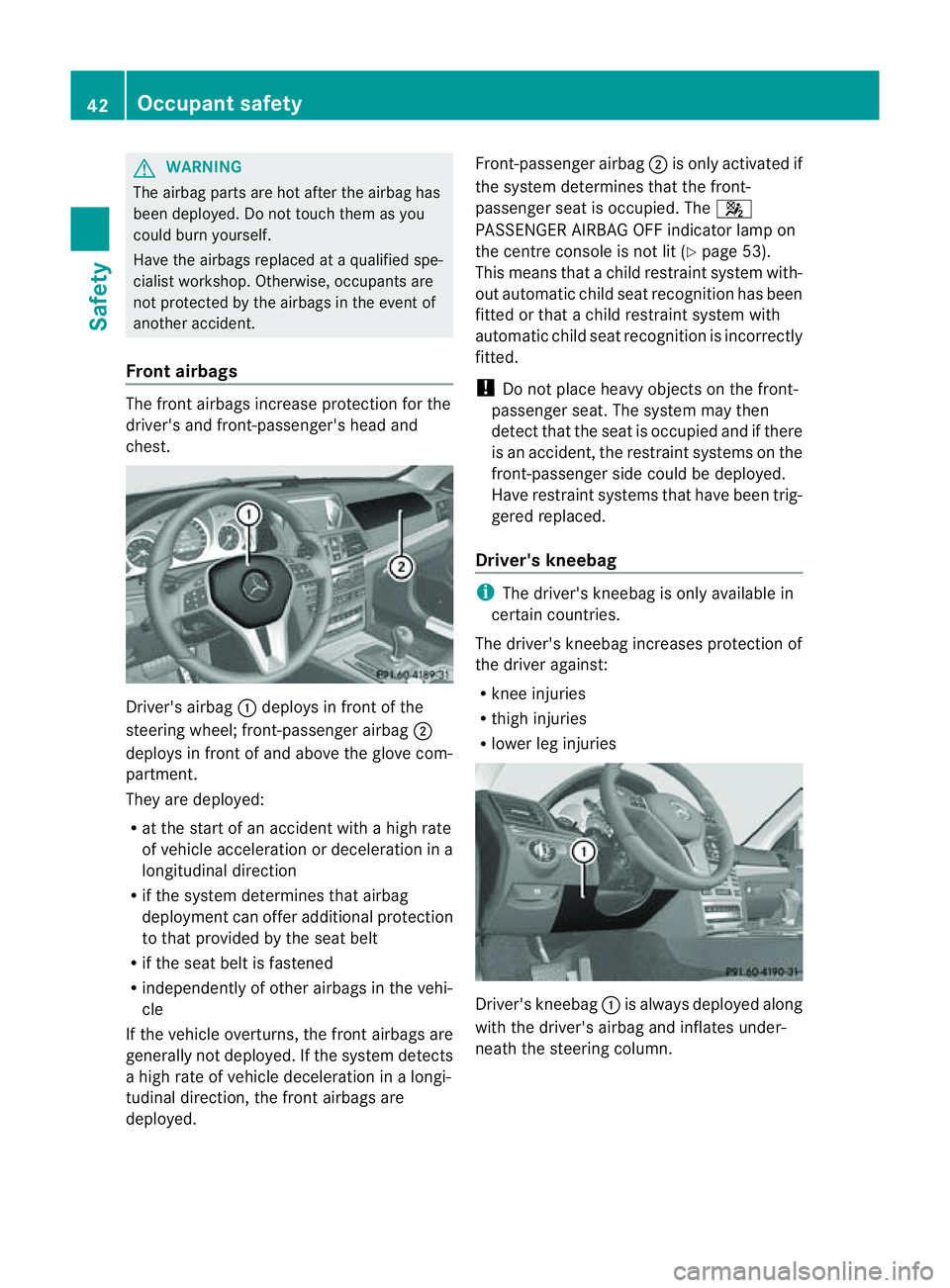
G
WARNING
The airbag parts are hot after the airbag has
been deployed. Do not touch them as you
coul dburn yourself.
Have the airbags replaced at aqualified spe-
cialist workshop. Otherwise, occupants are
not protected by the airbags in the event of
another accident.
Fron tairbags The fron
tairbags increase protection for the
driver's and front-passenger's head and
chest. Driver'
sairbag :deploys in front of the
steerin gwheel; front-passenger airbag ;
deploys in front of and above the glove com-
partment.
They are deployed:
R at the start of an accident with ahigh rate
of vehicle acceleration or deceleration in a
longitudinal direction
R if the system determines that airbag
deploymen tcan offer additional protection
to that provide dbytheseat belt
R if th eseat belt is fastened
R independently of other airbag sinthe vehi-
cle
If the vehicle overturns,t he front airbags are
generally not deployed. If the system detects
ah igh rate of vehicle deceleration in alongi-
tudinal direction, the front airbags are
deployed. Front-passenger airbag
;is only activated if
the system determines that the front-
passenger seat is occupied. The 4
PASSENGER AIRBAG OFF indicator lamp on
the centre console is not lit (Y page 53).
This means that achild restraint system with-
out automatic child seat recognition has been
fitted or that achild restraint system with
automatic child seat recognition is incorrectly
fitted.
! Do not place heavy objectsont he front-
passenger seat. The system may then
detect that the seat is occupied and if there
is an accident, the restraint systems on the
front-passenger side could be deployed.
Have restraint systems that have been trig-
gered replaced.
Driver's kneebag i
The driver's kneebag is only available in
certain countries.
The driver's kneebag increases protection of
the driver against:
R knee injuries
R thigh injuries
R lower leg injuries Driver's kneebag
:is always deployed along
with the driver's airbag and inflates under-
neath the steering column. 42
Occupant safetySafety
Page 46 of 353
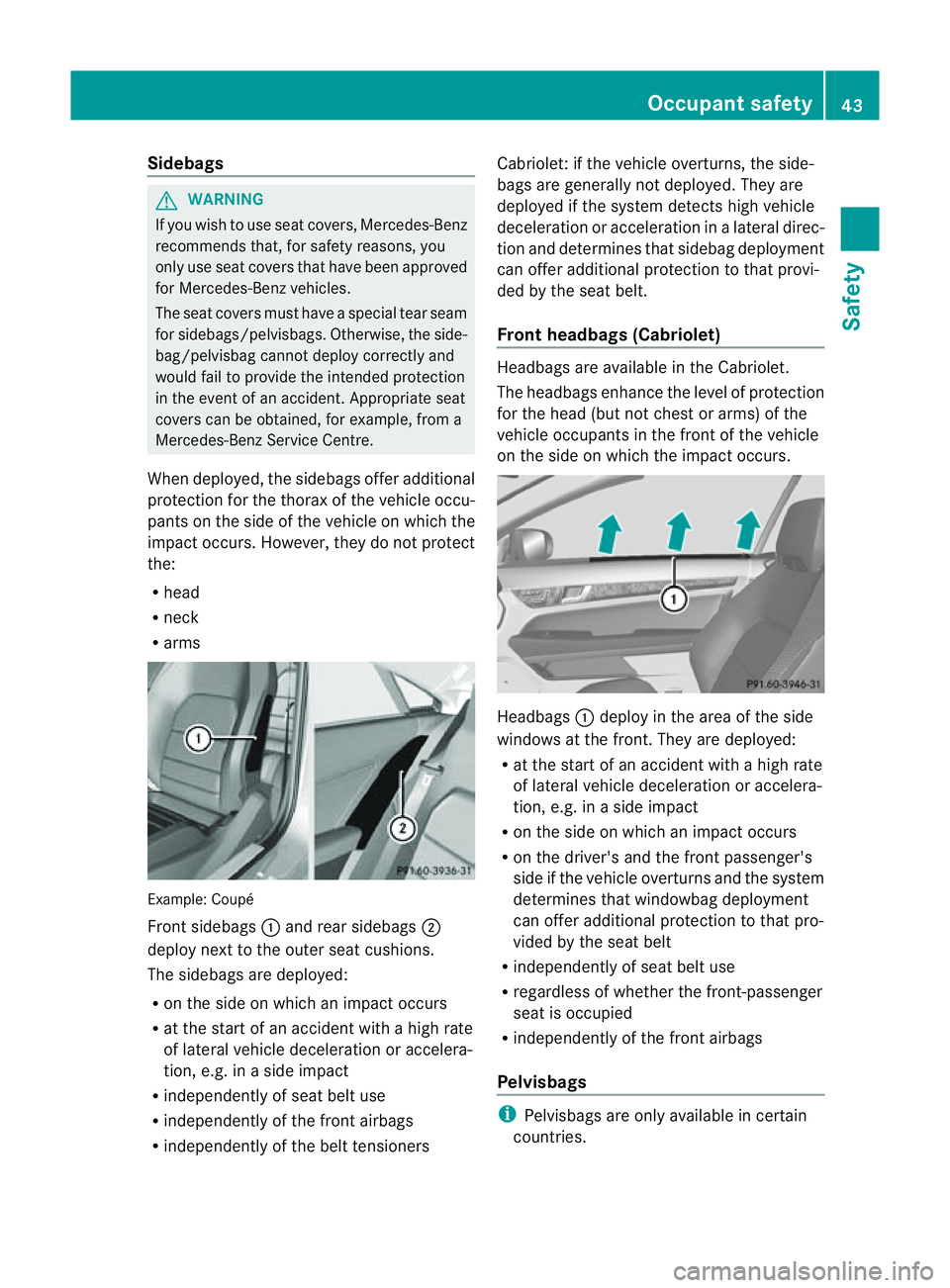
Sidebags
G
WARNING
If you wish to use seat covers, Mercedes-Benz
recommends that, for safety reasons, you
only use seat covers that have been approved
for Mercedes-Benz vehicles.
The seat covers must have aspecial tear seam
for sidebags/pelvisbags. Otherwise, the side-
bag/pelvisbag cannot deploy correctly and
would fail to provide the intended protection
in the event of an accident. Appropriate seat
covers can be obtained, for example, from a
Mercedes-Benz Service Centre.
When deployed, the sidebags offer additional
protection for the thorax of the vehicle occu-
pants on the side of the vehicle on which the
impact occurs. However, they do not protect
the:
R head
R neck
R arms Example: Coupé
Front sidebags
:and rear sidebags ;
deploy next to the outer seat cushions.
The sidebags are deployed:
R on the side on which an impact occurs
R at the start of an accident with ahigh rate
of lateral vehicle deceleration or accelera-
tion, e.g. in aside impact
R independently of seat belt use
R independently of the front airbags
R independently of the belt tensioners Cabriolet: if the vehicle overturns, the side-
bags are generally not deployed. They are
deployedift
he system detectsh igh vehicle
deceleration or acceleration in alateral direc-
tion and determines that sidebag deployment
can offer additional protection to that provi-
ded by the seat belt.
Front headbags (Cabriolet) Headbags are available in the Cabriolet.
The headbagse
nhance the level of protection
for the head (but not chest or arms) of the
vehicle occupants in the front of the vehicle
on the side on which the impact occurs. Headbags
:deploy in the area of the side
windows at the front.T hey are deployed:
R at the start of an accident with ahigh rate
of lateral vehicle deceleration or accelera-
tion, e.g. in aside impact
R on the side on which an impact occurs
R on the driver's and the front passenger's
side if the vehicle overturns and the system
determines that windowbagd eployment
can offer additional protection to that pro-
vided by the seat belt
R independently of seat belt use
R regardless of whether the front-passenger
seat is occupied
R independently of the front airbags
Pelvisbags i
Pelvisbags are only available in certain
countries. Occupant safety
43Safety Z
Page 47 of 353
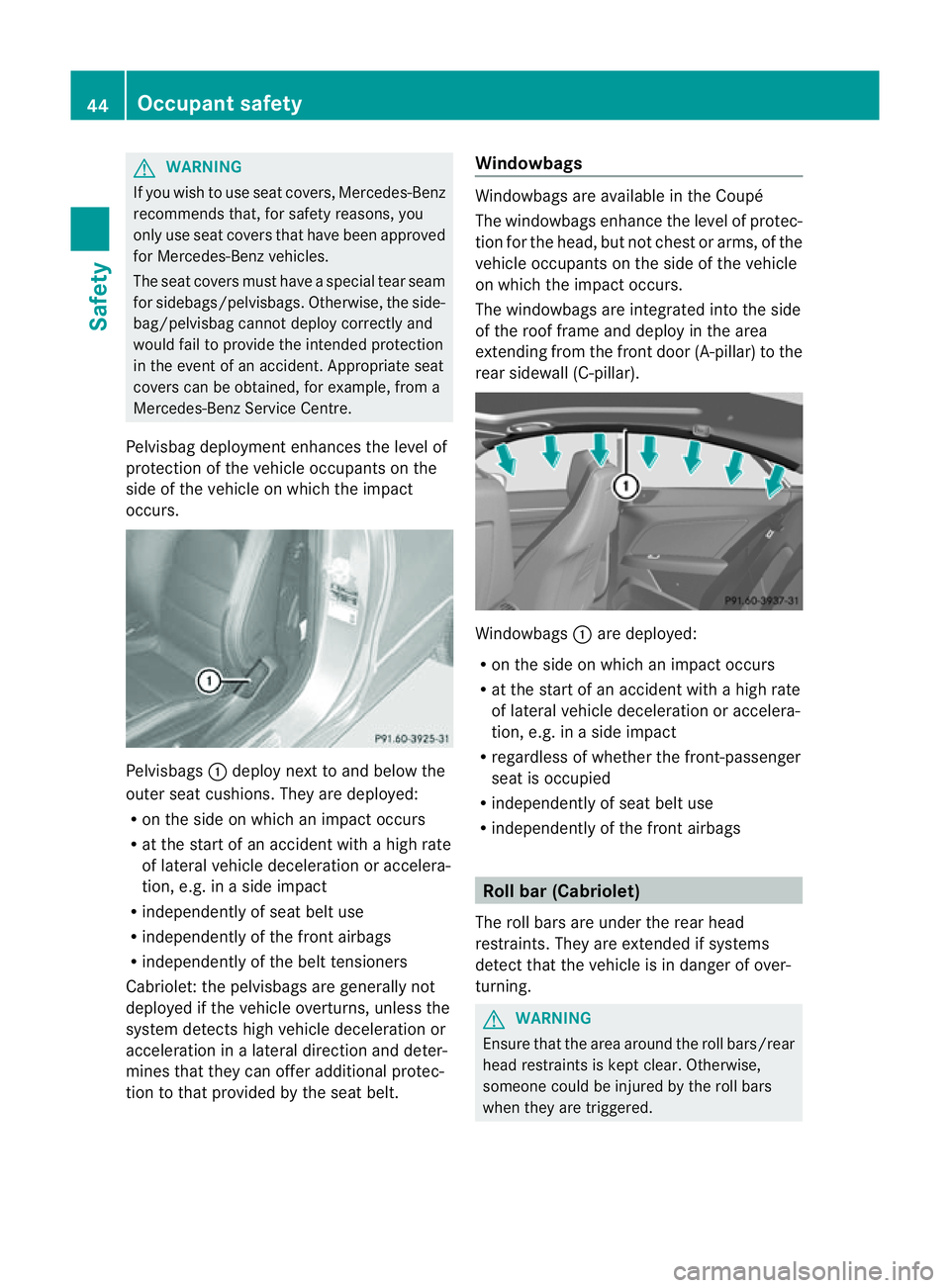
G
WARNING
If you wishtou se seat covers, Mercedes-Benz
recommends that, for safety reasons, you
only use seat covers that have been approved
for Mercedes-Benz vehicles.
The seat covers must have aspecial tear seam
for sidebags/pelvisbags. Otherwise, the side-
bag/pelvisbag cannot deploy correctly and
would fail to provid ethe intended protection
in the event of an accident. Appropriate seat
covers can be obtained, for example, from a
Mercedes-Benz Service Centre.
Pelvisbagd eployment enhances the leve lof
protection of the vehicl eoccupants on the
side of the vehicl eonwhich the impact
occurs. Pelvisbags
:deploy next to and below the
outer seat cushions. They are deployed:
R on the side on which an impact occurs
R at the start of an accident with ahigh rate
of latera lvehicl edeceleratio noraccelera-
tion, e.g. in asidei mpact
R independentl yofseatb elt use
R independently of the fron tairbags
R independently of the belt tensioners
Cabriolet :the pelvisbagsa re generally not
deployed if the vehicle overturns,u nless the
system detects high vehicle deceleration or
acceleration in alateral direction and deter-
mines that they can offer additional protec-
tion to that provided by the seat belt. Windowbags Windowbags are available in the Coupé
The windowbags enhance the level of protec-
tion for the head, but not chest or arms, of the
vehicle occupants on the side of the vehicle
on which the impact occurs.
The windowbags are integrated into the side
of the roof frame and deploy in the area
extending from the front door (A-pillar) to the
rear sidewall (C-pillar).
Windowbags
:are deployed:
R on the side on which an impact occurs
R at the start of an accident with ahigh rate
of lateral vehicle deceleration or accelera-
tion, e.g. in aside impact
R regardless of whether the front-passenger
seat is occupied
R independently of seat belt use
R independently of the front airbags Roll bar (Cabriolet)
The roll bars are under the rear head
restraints. They are extended if systems
detect that the vehicle is in danger of over-
turning. G
WARNING
Ensure that the area around the roll bars/rear
head restraintsisk ept clear. Otherwise,
someone could be injured by the roll bars
when they are triggered. 44
Occupant safetySafety
Page 48 of 353

When the roll bars are extended, the rear
head restraints also extend automatically.
Oncet he roll bars are extended, you can no
longer lower the rear head restraints. The soft
top can no longer be operated. In this case,
visit the nearest qualified specialist work-
shop. G
WARNING
If the roll bar is malfunctioning, the A
Malfunction Consult workshop message
appears in the multifunction display. The roll
bars will then not be extended in the event of
an accident .This could result in severe or
even fatal injuries to you and other occupants.
In this case, visit aqualified specialist work-
shop immediately and have the roll bar
checked. PRE-SAFE
®
(preventative occupant
protection)
PRE-SAFE ®
takes pre-emptive measures to
protect occupants in certain hazardous sit-
uations.
PRE-SAFE ®
intervenes:
R in emergency braking situations, e.g. if BAS
is activated or for vehicles with DISTRONIC
PLUS, BAS PLUS intervenes powerfully
R if the radar sensor system detects an immi-
nent danger of collision in certain situa-
tions (on vehicles with DISTRONIC PLUS)
R in critical driving situations, e.g. when phys-
ical limits are exceed and the vehicle under-
steers or oversteers severely
PRE-SAFE ®
takes the following measures
depending on the hazardous situation detec-
ted:
R the front seat belts are pre-tensioned.
R vehicles with the memory function: it
adjusts the front-passenger seat if it is in
an unfavourable position. R
vehicles with amulticontour seat: the air
pressure in the seat side cushions and in
the backrest side bolsters is increased.
R if the vehicle skids, the front side windows
and, on the Coupé,t he panorama sliding
sunroof, are closed so that only asmall gap
remains.
If the hazardous situation passes without
resulting in an accident, PRE-SAFE ®
slackens
the belt pretensioning. The air pressure in the
side bolsters on the multicontour seat is
reduced again. All settings made by PRE-
SAFE ®
can then be reversed.
If the seat belts are not released:
X Move the backrest or seat back slightly, but
only when the vehicle is stationary.
The belt pretensionin gisreduced and the
locking mechanism is released. G
WARNING
When adjusting the seat, make sure that
nobody can become trapped.
! Make sure that there are no objectsint he
footwell or behind the seats when moving
the seat back. There is arisk that the seats
and/or the objectsc ould be damaged.
More information about seat-belt adjust-
ment, aconvenience function integrated into
PRE-SAFE ®
,c an be found in the "Seat-belt
adjustment" section (Y page 49). NECK-PRO head restraints
The NECK-PRO head restraints increase pro-
tection to the driver's and front passenger's
head and neck.Tot his end, the NECK-PRO
head restraints on the driver's and front-
passenger seats are moved forwards and
upwards in the event of arear-end collision of
ac ertain severity. This provides better head
support. Occupant safety
45Safety Z
Page 49 of 353

G
WARNING
Only use headr estraint covers which have
been tested and approved by Mercedes-Benz
for yourv ehicle model.
The use of non-approved head restraint cov-
ers may preven tNECK-PRO head restraints
from triggering properly. Consequently, the
NECK-PRO head restraints cannot provide the
intended level of protection.
Consult aMercedes-Benz Service Centre
regarding availability.
If the NECK-PRO head restraint shave been
triggered in an accident, reset the NECK-PRO
head restraint sonthe driver’s and front-
passenger seat (Y page 46). Otherwise, the
additional protection will not be available in
the event of another rear-en dcollision. You
can recognise when NECK-PRO head
restraint shave been triggered by the fact that
they have moved forwards and can no longer
be adjusted. Resetting triggered NECK-PRO head
restraints
Following arear-en dcollision, Mercedes-
Benz recommends that you have NECK-PRO
head restraint schecked at aqualified spe-
cialist workshop, e.g. aMercedes-Benz
Service Centre.
i Resetting the NECK-PRO head restraints
requires alot of strength. If you have diffi-
culty resetting the NECK-PRO head
restraints, have this work carried out at a
qualified specialist workshop, e.g. a
Mercedes-Benz Service Centre. Example: Coupé
X
Tilt the top of the NECK-PRO head restraint
cushion forwards in the direction of
arrow :.
X Push the NECK-PRO head restraint cushion
down in the direction of arrow ;as far as
it will go.
X Firmly push the NECK-PRO head restraint
cushion back in the direction of arrow =
until the cushion engages.
X Repeat this procedure for the second
NECK-PRO head restraint. Seat belts
Important safety notes Seat belts are the most effective means of
restraining the movemen
tofvehicle occu-
pants in the event of an accident. This
reduces the risk of vehicle occupant scoming
into contact with parts of the vehicle interior. G
WARNING
As eat belt which is not worn correctly, or
which has not been engaged in the seat belt
buckle correctly, cannot perform its intended
protective function .Under certain circum-
stances, this could cause severe or even fatal
injuries in the event of an accident.
Make sure that all occupant s–inparticular,
pregnan twome n–w ear their seat belt cor-
rectly at all times.
R The seat belt must fit snugly on your body
and must no tbetwisted. Therefore, avoid 46
Occupant safetySafety
Page 50 of 353
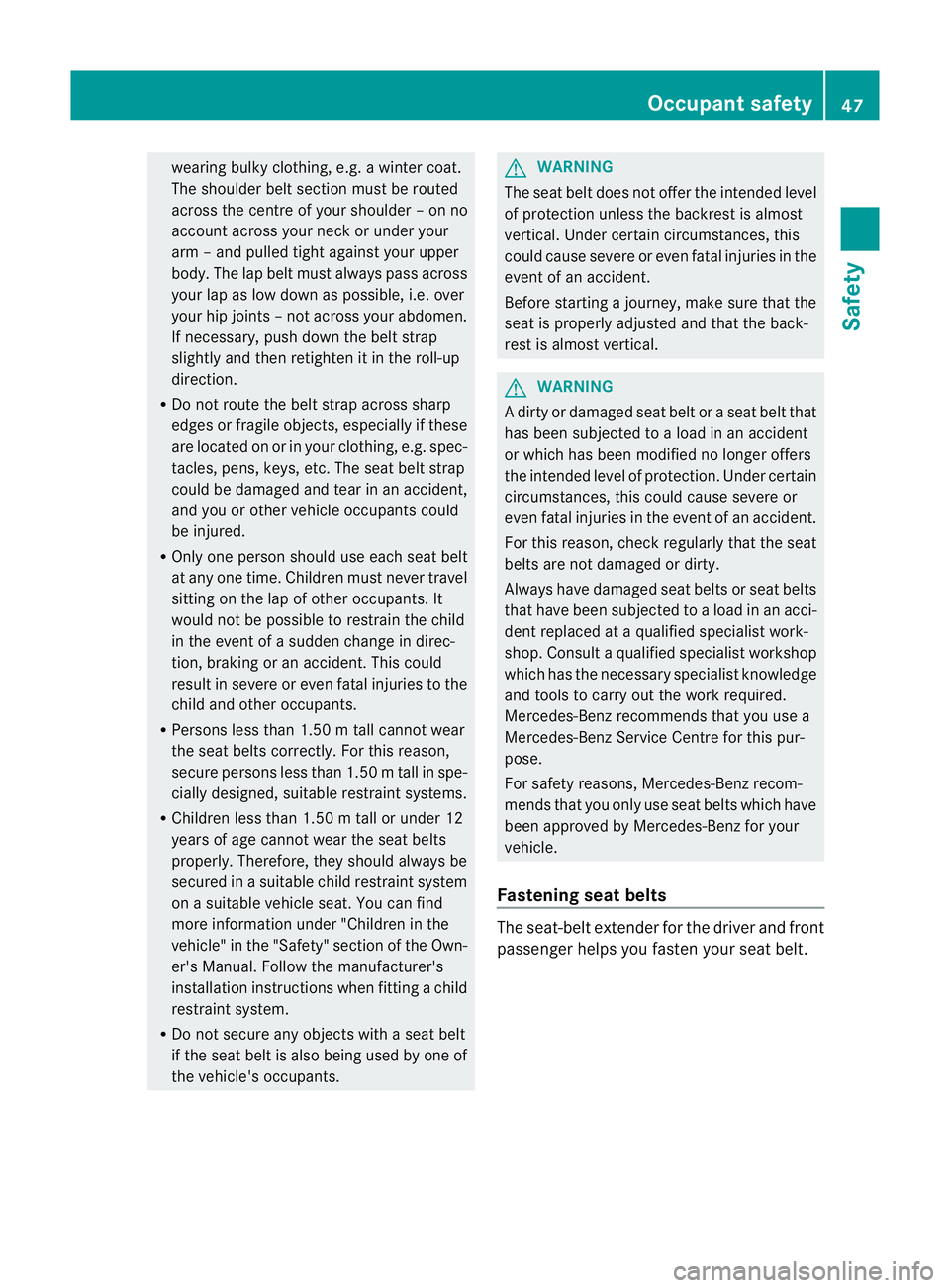
wearin
gbulky clothing, e.g .awinter coat.
The shoulde rbelt section must be routed
across the centre of your shoulder –onno
account across your neck or under your
arm –and pulled tight against your upper
body .The lap belt must always pass across
your lap as low down as possible, i.e. over
your hip joints–n ot across your abdomen.
If necessary, push down the belt strap
slightly and then retighten it in the roll-up
direction.
R Do not route the belt strap across sharp
edges or fragile objects, especially if these
are located on or in your clothing, e.g. spec-
tacles, pens, keys, etc. The seat belt strap
could be damaged and tear in an accident,
and you or other vehicle occupant scould
be injured.
R Only one person should use each seat belt
at any one time. Children must never travel
sittin gont he lap of other occupants. It
would not be possible to restrain the child
in the event of asudden change in direc-
tion, braking or an accident .This could
result in severe or even fatal injuries to the
child and other occupants.
R Persons less than 1.50 mtall cannot wear
the seat belts correctly. For this reason,
secure persons less than 1.50 mtall in spe-
cially designed ,suitable restraint systems.
R Children less than 1.50 mtall or unde r12
years of age canno twear the seat belts
properly. Therefore, they should alway sbe
secured in asuitable child restraint system
on asuitable vehicle seat. You can find
more information under "Children in the
vehicle" in the "Safety" section of the Own-
er's Manual. Follow the manufacturer's
installation instructions when fitting achild
restraint system.
R Do not secure any objects with aseat belt
if the seat belt is also being used by one of
the vehicle's occupants. G
WARNING
The seat belt does not offer the intended level
of protection unless the backrest is almost
vertical. Under certain circumstances, this
could cause severe or even fatal injuries in the
event of an accident.
Befor estarting ajourney, make sure that the
seat is properly adjusted and that the back-
rest is almost vertical. G
WARNING
Ad irtyord amaged seat belt or aseat belt that
has been subjected to aload in an accident
or which has been modified no longer offers
the intended level of protection. Under certain
circumstances, this could cause sever eor
even fatal injuries in the even tofanaccident.
For this reason, check regularly that the seat
belts are not damaged or dirty.
Alway shaved am aged sea tbelts or seat belts
that have been subjected to aload in an acci-
dent replaced at aqualified specialist work-
shop. Consult aqualified specialist workshop
which has the necessary specialist knowledge
and tools to carry out the work required.
Mercedes-Benz recommends that you use a
Mercedes-Benz Service Centr efor this pur-
pose.
For safety reasons, Mercedes-Benz recom-
mends that you only use seat belts which have
been approved by Mercedes-Benz for your
vehicle.
Fastening seat belts The seat-belt extender for the driver and front
passenger helps you fasten your seat belt. Occupant safety
47Safety Z
Page 51 of 353
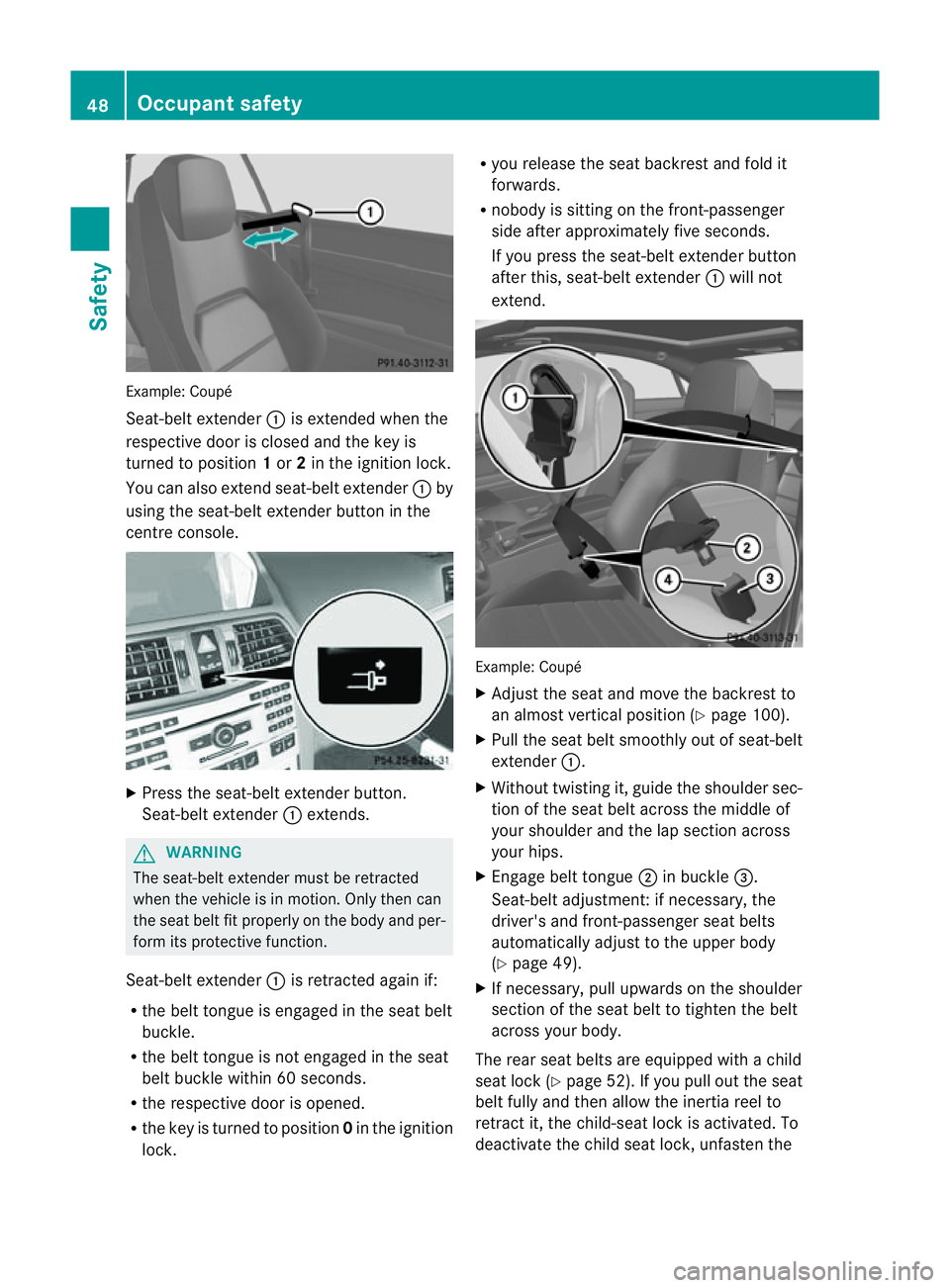
Example: Coupé
Seat-belt extender
:is extende dwhent he
respective door is closed and the key is
turned to position 1or 2in the ignition lock.
Yo uc an also extend seat-belt extender :by
using the seat-belt extende rbutton in the
centre console. X
Press th eseat-belt extender button.
Seat-belt extender :extends. G
WARNING
The seat-belt extender must be retracted
when th evehicl eisinm otion.Only then can
the sea tbelt fit properly on the body and per-
form its protective function.
Seat-belt extender :is retracted again if:
R the belt tongue is engaged in the seat belt
buckle.
R the belt tongue is not engaged in the seat
belt buckle within 60 seconds.
R the respective door is opened.
R the key is turned to position 0in the ignition
lock. R
you release the seat backrest and fold it
forwards.
R nobody is sitting on the front-passenger
side after approximately five seconds.
If you press the seat-belt extender button
after this, seat-belt extender :will not
extend. Example: Coupé
X
Adjust the seat and move the backrest to
an almost vertical position (Y page 100).
X Pull the seat belt smoothly out of seat-belt
extender :.
X Without twistin git, guide the shoulder sec-
tion of the seat belt across the middle of
your shoulder and the lap section across
your hips.
X Engage belt tongue ;in buckle =.
Seat-belt adjustment:ifn ecessary, the
driver's and front-passenger seat belts
automatically adjust to the upper body
(Y page 49).
X If necessary, pull upwards on the shoulder
section of the seat belt to tighten the belt
across your body.
The rear seat belts are equipped with achild
seat lock (Y page 52). If you pull out the seat
belt fully and then allow the inertia reel to
retract it, the child-seat lock is activated. To
deactivat ethe child seat lock, unfasten the 48
Occupant safetySafety